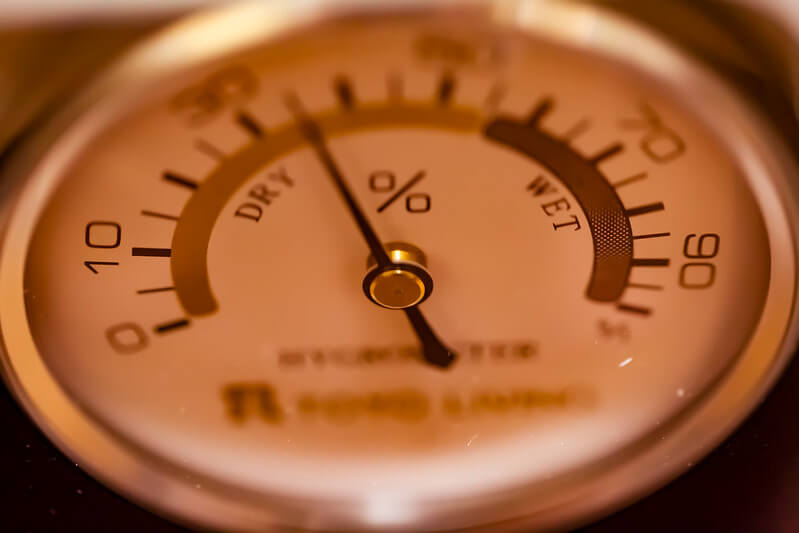Tired of experiencing high or low levels of humidity in your home or a room? There are diffferent ways you can measure the humidity in a room. In this post, i show you exactly six methods I have tried to measure the humidity in my home.
What is Humidity?
Humidity is defined as the concentration of water vapor present in the air. Water vapor is the gaseous state of water usually in the air. Absolute humidity describes the water content in the air. Relative humidity is a state of absolute humidity relative to a maximum humidity- and specific humidity – the ratio of water vapor mas to total moist air parcel mass.
[snippet]What is a Comfortable Indoor Humidity Level?
Generally, the ideal humidity level for your home or a room should be around 45-55%. In the winter, you can keep the humidity at around 30-40%, which keeps condensation at bay. A humidity level of above 40% will create excess moisture and enable condensation to form on your windows.
[/snippet]How to Measure Humidity in A Home
1. Use of a Hygrometer
One of the best and most used methods is an essential instrument called a hygrometer, mostly used in meteorological science. The instrument has numerous commercial uses, but its main purpose is measuring the amount of water vapor in the air, also known as humidity.

The instrument provides the amount of moisture space is confined to and compares it to the maximum amount of moisture in a room. A hygrometer depends on other quantities like measuring temperature, mass, or pressure because they absorb moisture in your room.
The device has a screen where the humidity is recorded and computed before you can get the humidity levels in your room. A hygrometer should be calibrated at least once a year to ensure the most accurate results.
2. Use of Ice Cubes
This method uses a glass of water and ice cubes to determine the humidity level in your room. This method shows if your room’s air is humid or how dry it is.
The technique takes place where you can place the glass and plunk the ice cubes in a room where you might suspect the moisture being too high or too low. After immersing the ice cubes in the glass of water, you should leave it for around 10 minutes.
After the ten minutes,’ an inspection should be done on the outside of the glass to see whether condensation (the change of water from its gaseous form into liquid water) has occurred.
If it has formed outside the glass, then your room has a high moisture level. To control the high moisture level in your room, one should add plants that highly absorb moisture in the atmosphere in your space. If the outer part of the glass happens that there is no condensation, you should consider adding a humidifier to your room because dry air can lead to health issues.
3. Performing Wet and Dry Bulb Temperature Test
It’s an easy way to measure humidity using two thermometers where one thermometer is used as the wet bulb while the other is used as a dry bulb. The thermometers should be well shaken before starting the experiment to ensure that the mercury in each thermometer settles in the bulb.
The bulb should be moistened using a dampened piece of cotton. The water temperature in a given room should be used for the experiment. The thermometers, both the wet and the dry bulb, should be placed and duct-taped on the cardboard to be projected outwards.
In this method, a fan is needed if you want to check the moisture level, and it is placed pointing to the thermometers; after the given five minutes, you should check and record the temperatures in every thermometer.
The temperatures in the thermometer and the readings from the wet-bulb should be subtracted from the temperatures of the dry bulb. The results are usually in degrees Celsius, also called the depression value that shows the percentage of humidity in the room.
4. Use of Hair as a Hygrometer
In this method, hair is used to measure humidity in a room. Hair strands usually get longer when the humidity is high and contract when humidity is low.
The length of the strand is usually dependable and can be used as a hygrometer. If you want to test the efficiency of this method, you use two hair strands, and on one, use a blow dry where the hair shrinks, showing there is 0% moisture. The other strand should be sprayed with water, and it will expand, which indicates 100% of humidity.
5. The Dew Point Temperature
Dew point is the temperature at which air is cooled to become saturated with water vapor, and when it’s cooled further, it condenses and usually forms liquid water. When the dew point is measured, it is usually able to provide the following reasons: The reading usually shows the temperature that should be maintained in gas to avoid condensation.
After the reading shows the humidity in your room or space and can tell the present amount of vapor. The dew point is usually expressed in temperature readings; if it goes below the freezing point, the frost point (the temperature below 32 degrees Celsius) applies.
6. Concentration of Vapor
It is the mass of water vapor present per unit volume of your space. In this method, a space of one-meter cubic contains ten grams of vapor. You can tell your humidity if the vapor is more or less than ten grams.
Happy Taking Measurements
The points above show the use of a hygrometer and other methods that one can use to determine the humidity of your room. It also has an explanation of how each one of them is used.


